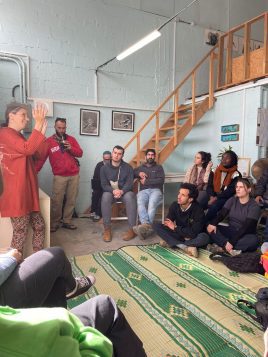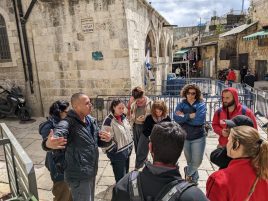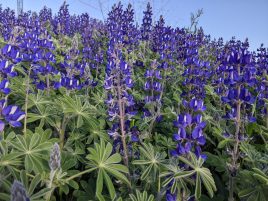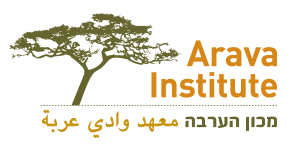by Sara Weissel, Spring 2024 intern
Last week, our students and interns went on a three-day-trip off campus as part of the compulsory weekly Dialogue Forum program.
As one of seven interns, I was fortunate enough to come along. At the Institute, the Israeli-Palestinian conflict – its history and the current war – is always present, in the lessons in the classrooms, in conversations, and in the basic fact of who intentionally comprises our community. But living in Ketura means there’s always a physical abstraction away from that reality. Surrounded by sand, committed to understanding what it means to want peace, we are barricaded in daily life from almost everything that swirls in the air – unless we make an active choice to see it. The semester trip suspended that option to choose for three days, reminding us that the concepts in our textbooks or our casual words to one another are all attached to real people, with real lives.

The first day started with an early morning bus ride from Ketura to Al-Foura, an unrecognized Bedouin school about two hours to the north in the Negev. Fareed Mahameed, Assistant Director of the Center for Transboundary Water Management, and an Arava Institute alum, has been working with the Center’s Director Dr. Clive Lipchin to bring an-off grid waste-water management system to the school. Under current Israeli government regulations, around half of the 170,000 Bedouin citizens of Israel live in villages deemed “illegal.” This term implies a variety of things – most commonly, that they don’t have the all-elusive building permit – but results are generally the same. Village homes, many belonging to former Bedouin IDF soldiers, are torn down, and those which do remain are unable to attach to state-wide power, water or sewage systems.
The Israeli Department of Education mandate requiring that all Israeli citizens attend school through 12th grade has resulted in permitted schools being built for Bedouins. But since utilities are handled by local municipalities, resources at schools are usually scarce. The goal of the Institute’s initiative at Al-Foura is to help fix the lack of proper sewage draining by building a completely off-grid system to manage wastewater.

We then went for a short bus ride to the city of Arad, to meet Yonat Mordoch, another alumna. Yonat came to the Institute as part of a joint Master’s program with Ben-Gurion University of the Negev, studying the history and current practices of Bedouin plant-healing. She currently lives in Arad, teaching school groups in the area, and making natural cosmetics using local plants and traditional Bedouin techniques.
If I were forced to pick one theme of the trip it would be: community, on all levels. As a current intern, meeting and hearing from alumni was a consistent reminder of the collective responsibility that is ingrained in the Institute. Hoping for a different future doesn’t culminate in the four months here; it starts now, but only lasts through individual commitment after we leave. After the beginning of the current war, Yonat was one of the initiators of “Good Neighbours” a group that organizes joint meals for Arab and Jewish residents of the Negev to find solidarity and points of connection. One Bedouin organizer of those meals, Yusuf Haswalah, came to speak with us at Yonat’s workshop as well. Hearing him describe how meals became an all-important place of conversation and mutual exchange, I was reminded of that commitment, and the power that comes from how communities overlap: without listening to our neighbors, any work done will be meaningless.
Yusuf told us that he draws his sense of the future from the need to “not get stuck in the pain of the past.” It’s a phrase that comes up frequently at the Institute; it’s beautiful to hear, but in reality almost impossible to fathom. Yusuf’s own home is currently up for demolition, and he detailed to us the impossibility of finding a lawyer to represent him and his children. I don’t live under the threat of someone demolishing my home. Meeting like this made the unequal weight of reality come to the surface in the air, reminding me in that room of the collective responsibility to never forget our neighbors, especially when the world is oriented towards suppressing them.
After Arad, we went on to our final destination of the evening: Wahat Al-Salam/Neve Shalom, the only intentionally mixed community of Palestinians and Israelis currently in Israel. There we met another alum, Diyar Daoud, who grew up in the village. During his tour he outlined the community’s history and approach to shared living: Founded in the 1970s, all children learn Hebrew and Arabic, and the village intentionally keeps the number of Palestinians and Israelis equal.
On the tour, he pointed out the School of Peace, the first educational institution in Israel promoting broad-scale change towards peace and more humane, egalitarian and just relations between Palestinians and Jews. Both of our semester’s dialogue facilitators, Baraa and Lior, trained there. In 2020, Jewish settlers burned down the school, and its new building has just been completed.
The next morning, we met with one of the school’s directors, now retired, Dr. Nava Sonnenstein. Being one of the developers of the dialogue method we are currently practicing, she was asked by one of the students what sort of changes she thinks we will experience. She said that “Jews begin to accept the weight of responsibility of an unequal power dynamic.” And Palestinian’s are freed from “their silence, learning how to begin to advocate.” For me, hearing her say that shifted something in the room, and between all of us. For such a complex question to have such a simple answer put a deep weight into her words: After my first month at the Institute, I have just the smallest sense of what they might mean. She was hinting towards a destination that we all knew of before coming here, but having started moving towards getting there, the full weight of the end is only now apparent.

After leaving Wahat Al-Salam/Neve Shalom, we went to Jerusalem. We split into two groups for a tour of the Muslim Quarter of the Old City, and Sheikh Jarrah, a neighborhood in East Jerusalem.
At the end of our trip, Tareq Nasser, a Palestinian Urban Planner/Activist based in East Jerusalem voiced how after the beginning of the war, he kept away from West Jerusalem for a few weeks out of fear. I know from conversation with students and staff that there was a certain amount of trepidation around us traveling as a group to East Jerusalem. When we shared this with Tareq, his response was: if people like us won’t make these journeys, who will? There is no better explanation of the core of this trip, and for me, the Institute. Actions, so often, speak louder than words. Learning, as a group, about the encroachment of occupation isn’t going to stop it. But our physical presence was, to me, an action of sorts: a commitment to further actions, a commitment to refuse ignorance about reality.

After our geo-political tour, we crossed into West Jerusalem, to learn from West Jerusalemite Gadi Dahan about a local environmental project to preserve natural wild spaces in Jerusalem. Gadi is trying to prevent a police station from being erected on a hill near the UN buildings, as on that hill grow over 220 different types of native flowers, as well as fields of vibrant purple lupin flowers. of native flowers, as well as fields of vibrant purple lupin flowers.
The day culminated in a talk and dinner in FeelBeit, a joint Palestinian-Israeli community center and event space used for art making and shows. We learned from FeelBeit staff member Muna Barakat about the struggles the center underwent during the Covid19 pandemic, and what it means for them to have a place where all community members can comfortably express a variety of political ideas.
The next morning began at Gazelle Valley, an urban nature reserve near Givat Mordechai. We once again spoke about the power of intentional community: Developers had tried to build 6,000 apartments on the reserve, and after defeating them, the community itself decided on the future of their nature, opting to create the current reserve. It became a sanctuary for gazelles, growing from four gazelles to 150. Recently a turtle rehabilitation center was added to the grounds. And while learning about the intricacies of gazelle territory marking was fascinating, for me what stood out the most was hearing from our guides about their work with children in nature. Since the beginning of the war, Gazelle Valley guides have been taking groups of children evacuated from their homes due to the war for multi-day trips into the Negev. “The change is almost instantaneous. We get out there, and you can see them relax, see them start to enjoy things again.”
The rest of the day was then spent at Sinsila, an East Jerusalem community initiative “whose goal is to heal the urban environment of Jerusalem by providing local and sustainable solutions”, founded by Tareq Nasser and Arava alum Liel Maghen. Tareq told us about urban and green place-making, about what it means to dream of a beautiful world – but most importantly, as he emphasized, how to turn that dream into action. For him, “there is no hope without action. It is action itself that creates hope.” With this dream he and his partners developed a honey production initiative, designed to uplift East Jerusalemite women while simultaneously bringing greenery to urban spaces. The unemployment rate amongst East Jerusalemite women is around 80%; Sinsila is helping to combat this by installing honey-bee hives on women’s roofs, and helping them then sell their honey.
We learned about beekeeping, and how honey is harvested. Not only does Sinsila’s honey promote social change, it also has natural health benefits as the bees are raised without factory-honey-farming feeding measures which are destructive to the lifespan of bees. We also met with Arava alumna Avia Hirshfeld, who after graduating became part of setting up the Jerusalem Food Rescuers, a community food-waste program that collects the thousands of tons of food waste from Jerusalem’s food markets, donating back into the community and launching free weekly dinners made from leftover food.
And with that, it was time for the last guest of the trip, architect Zeev Arad, who gave us a lesson in Jerusalem’s incredibly complex building laws, and how he works in a city nearly entirely defined by territorial land conflict.
And then it was time to return to Ketura. My head was full – and has remained that way since coming back. I return back to the classroom and my office with an understanding of the responsibility of this Institute. Without trips like this one, the world we are trying to build here would remain obsolete: stuck in looping disconnection.
A big thank you must go to all the staff who made it possible – without you, there is no vehicle for change!

